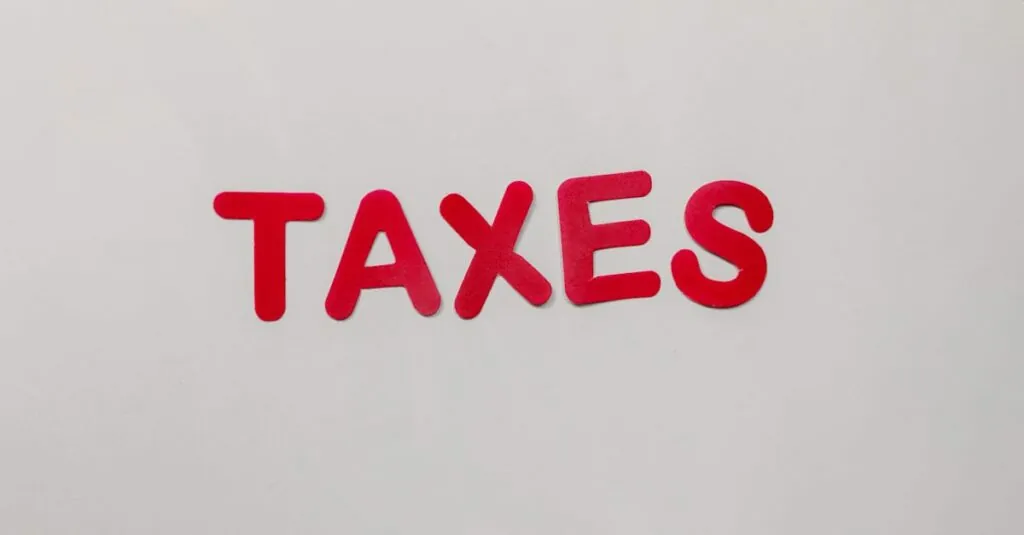Table of Contents
ToggleProperty tax policy might not sound like the most thrilling topic, but it’s more exciting than a surprise tax bill in July. This essential aspect of local government funding affects everything from public schools to road maintenance. Understanding how these policies work can save homeowners from feeling like they’ve been hit by a runaway property tax train.
Imagine being able to navigate the twists and turns of your local tax system like a pro. With the right insights, anyone can turn tax confusion into clarity. Dive into the world of property tax policy, where knowledge is power and a little humor goes a long way. Get ready to uncover the secrets that could make tax season feel less like a horror show and more like a well-rehearsed comedy.
Overview of Property Tax Policy
Property tax policy involves regulations and rules governing how local governments assess taxes on real estate. Local authorities determine tax rates, which can fluctuate annually based on property values and budgetary needs. Structures such as homes, commercial buildings, and vacant land fall under this policy’s jurisdiction.
Several elements contribute to property tax calculations. The assessed value of a property, established by appraisers, plays a crucial role. These appraisers consider factors like property size, location, and improvements made to the property. Tax exemptions and credits further influence the final tax amount. For example, qualifying veterans or senior citizens might benefit from reduced tax burdens.
Understanding how property tax policy impacts community funding is essential. Revenues generated primarily support local services, including education, emergency services, and infrastructure development. States vary in their reliance on property taxes, with some depending more heavily on them for funding essential services.
Active engagement with property tax policies empowers homeowners. It allows them to examine their assessments and dispute inaccuracies if necessary. Familiarity with local tax codes facilitates better financial planning during tax season. Keeping abreast of changes to tax laws can mitigate unexpected expenses.
Navigating property tax policies proves beneficial for real estate investors too. Knowledge of local tax incentives can enhance investment opportunities and profitability. Staying informed enables strategic decisions that optimize tax-related benefits, ultimately impacting overall business operations.
Historical Context
Understanding property tax policy requires knowledge of its history. This context reveals how local taxation has developed over time.
Evolution of Property Tax Policy
Property taxation dates back to ancient civilizations. Societies like Mesopotamia implemented taxes based on land and agricultural outputs. By the 19th century, many states in the U.S. adopted property taxes as a primary funding source for local services. This approach established a framework where property values directly influenced tax liabilities. As populations grew and urban areas expanded, property tax structures adapted to accommodate changing economic conditions. Today, local governments assess property taxes to support crucial services such as education and infrastructure, showcasing its evolution in addressing community needs.
Key Legislative Changes
Numerous legislative changes have shaped property tax policy. The introduction of the 1976 Tax Code established multiple property tax exemptions. These exemptions benefited groups like veterans and seniors, reflecting a shift towards supporting vulnerable populations. In 1980, Proposition 13 in California significantly limited property tax rates, influencing similar legislation in other states. Furthermore, the Tax Reform Act of 1986 streamlined property assessments, ensuring fairness and transparency. These critical developments laid the groundwork for today’s complex property tax landscape, where local authorities balance revenue needs with taxpayer protection.
Current Property Tax Policy Framework
Current property tax policies play a crucial role in funding local government services. These regulations directly affect the amount homeowners pay, making understanding essential for effective financial planning.
Types of Property Taxes
Property taxes primarily fall into three categories: ad valorem taxes, special assessments, and impact fees. Ad valorem taxes calculate based on property value, directly linking tax amounts to current market conditions. Special assessments target specific local projects, imposing fees on properties that benefit from improvements, such as road expansions or park developments. Impact fees help manage the costs associated with new developments, charging developers to cover the infrastructure demands they create. Each type of tax influences funding for essential community services differently.
Assessment Methods
Assessment methods vary across jurisdictions, but many rely on either market-value or mass appraisal techniques. Market-value assessments determine property worth through recent sales comparisons, reflecting the current housing market. Mass appraisal, on the other hand, uses statistical models to evaluate similar properties, facilitating quicker assessments over larger areas. Local assessors consider property size, location, and any improvements made during the evaluation process. Regular adjustments aim to keep assessed values current and fair for property owners.
Impact of Property Tax Policy
Property tax policy significantly affects communities, influencing both economic conditions and social dynamics. Understanding these impacts helps individuals grasp the broader implications of tax structures.
Economic Implications
Economic stability often hinges on property tax policies. Local governments rely on these taxes to fund essential services, including education and infrastructure. Businesses benefit when local services improve, as they attract more customers. Increased revenue from taxes enables better public facilities, enhancing overall living conditions. Additionally, a well-structured tax policy can incentivize real estate development and investment. Various exemptions may stimulate housing markets, promoting affordability for residents. By considering your local property tax rate, property owners can make informed financial decisions that ultimately contribute to local economic health.
Social Considerations
Social equity plays an integral role in property tax policy discussions. Fair tax assessments can alleviate financial burdens on vulnerable groups, including seniors and low-income families. Tax exemptions and credits support these populations, ensuring access to necessary services. Communities thrive when property tax revenues support local schools, public transportation, and social programs. These services enhance the quality of life for residents, fostering inclusivity and cohesion. Engaging with property tax policies empowers communities to advocate for fair assessments, helping mitigate disparities. Awareness and active participation can lead to positive changes that benefit the entire population.
Challenges in Property Tax Policy
Property tax policy faces significant challenges that affect its effectiveness and fairness. These challenges include equity concerns and administrative complexities.
Equity and Fairness Issues
Equity issues arise when property tax assessments disproportionately burden specific populations. Under-assessment of properties in affluent areas can lead to higher tax rates for lower-income neighborhoods. Fairness in tax liability becomes a crucial consideration, as accurate assessments ensure that all taxpayers contribute equitably to funding local services. Disparities in valuation practices can further exacerbate these inequities. For example, a property facing different appraisal methods than similar nearby properties creates an unfair tax burden. States and local governments continuously seek methods to enhance fairness, such as implementing progressive tax structures or offering targeted exemptions to vulnerable groups.
Administrative Complexities
Administrative complexities in property tax policy complicate the assessment process. Different jurisdictions employ varying methodologies to determine property values. Some regions utilize market-value assessments, whereas others might rely on mass appraisal techniques, resulting in inconsistencies. Local assessors face challenges in keeping property assessments current, especially in rapidly changing markets. Resource constraints often limit the frequency of reassessments, leading to outdated property values and inaccurate tax bills. Streamlining processes and employing technology may alleviate some administrative burdens. Innovative solutions, such as automated appraisal systems, support assessors in maintaining fair and accurate property tax assessments.
Future Trends in Property Tax Policy
Property tax policy is evolving, reflecting the complexities of modern economies and communities. Innovations and reforms play a vital role in shaping these changes.
Innovations and Reforms
New technologies enhance accuracy in property assessments, utilizing automated appraisal systems. Local governments increasingly adopt these innovations to streamline processes and improve transparency. Many jurisdictions explore tax incentives tailored for economic development, focusing on revitalization of distressed areas. Digital platforms facilitate easier access to property tax information, supporting taxpayers in understanding their obligations. Reform efforts often target simplification of valuation methods, making it easier for property owners to navigate the system.
Adapting to Changing Landscapes
Shifts in demographics and economic conditions require adaptive property tax policies. Urbanization influences revenue needs, prompting adjustments to tax structures. Local governments closely monitor housing trends, aligning tax rates with property values. Community engagement fosters discussions around fairness, ensuring diverse voices influence policy-making. Rapid technology adoption also encourages changes in assessment practices, leading to more equitable outcomes. As neighborhoods evolve, adapting property tax policies becomes essential to maintaining community resources.
Conclusion
Understanding property tax policy is crucial for homeowners and investors alike. It not only impacts financial planning but also shapes community dynamics and economic stability. By engaging with local tax policies and advocating for fair assessments, individuals can contribute to a more equitable system that supports essential services.
As property tax policies continue to evolve, staying informed about changes and innovations will empower taxpayers to navigate the complexities of the system. Embracing this knowledge can transform the often daunting tax experience into a proactive approach that benefits both individuals and their communities. Ultimately, awareness and participation in property tax discussions are key to fostering a fair and efficient taxation landscape.







